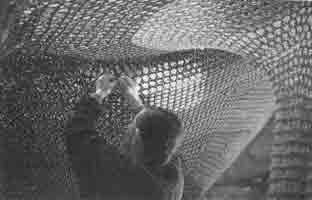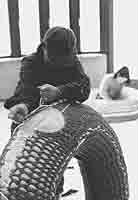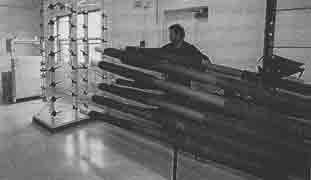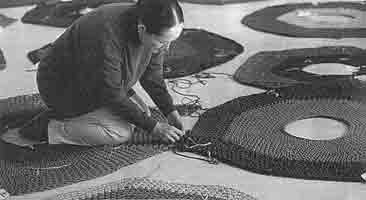![]()
horiuchi
more about the making of 'Rainbow Net'

horiuchi's work process
Although the go-ahead had been given, there was still much refinement of details and consultation. A new project manager was brought in and had to be 'inducted' into the scheme. Even at this late date, major details were being added, such as another of Charles' very practical suggestions - to have crocheted cushions that doubled as seating for the parents or as less hazardous 'play cushions' for smaller children or children with disabilities. All of this took up until March of 1999. The agreed date of completion was to be Spring of 2000. That left 13 months to make and complete the project


At least the yarn had already arrived. One ton of DuPont Nylon 6-6, a yarn with a size of 840 denier. It had been specially prepared into knitted 'stockings' at a factory in Ontario, and the idea of this was to make the dyeing process more manageable.
The stockings were cut into 6 kilogramme lengths and each of these was dyed. Once dry the stockings were ready to be wound onto bobbins, and the knitted stocking simply unravelled as it was being spooled onto the bobbin winding machine. A 840 denier yarn is not so very thick, however, so before making the nets could begin 5 ends of yarn had to be plied together, with 16 of these plied threads going to make the final 5 mm thick braided cord.


Horiuchi is at pains to point out how much her husband Charles and another colleague, Liz Fox, helped her out. Once the yarn was ready and the crocheting could begin she would be at work from 8.00 in the morning up until 5.00 pm - sometimes even 10.00 pm, often working in excuciatingly uncomfortable positions. As she worked she would keep in her mind's eye an image of the joy and pleasure of the children playing in it, and this would keep her going.
All three sections were finished, and freighted by air to Hokaido, whilst the bulkier cushions for the 'cushion play' area went by sea. In February 2000, with the July deadline in sight, they were re-united with the transported work at Sapporo and began the final stages. It took 3 men, including her husband Charles, to hang the nets and 4 helpers to finish off the 'play cushions', whilst Horiuchi joined the sections together and finished off the hanging pouch shapes. Two weeks later everything was ready for testing, and over the intervening months numerous small adjustments were made as the nets settled and stretched.
It's not so hard to imagine how painfully sweet that moment must have been for Horiuchi when, on the opening day, the first shouts and joyful cries echoed through the concrete dome. There were so many children waiting to try it out that they had to divide them into groups of 85 and set a time limit of 15 minutes for each group.

